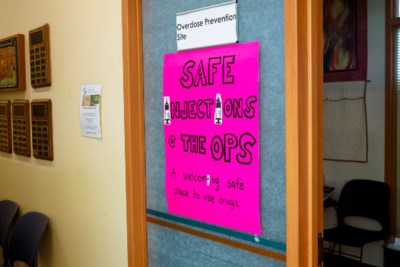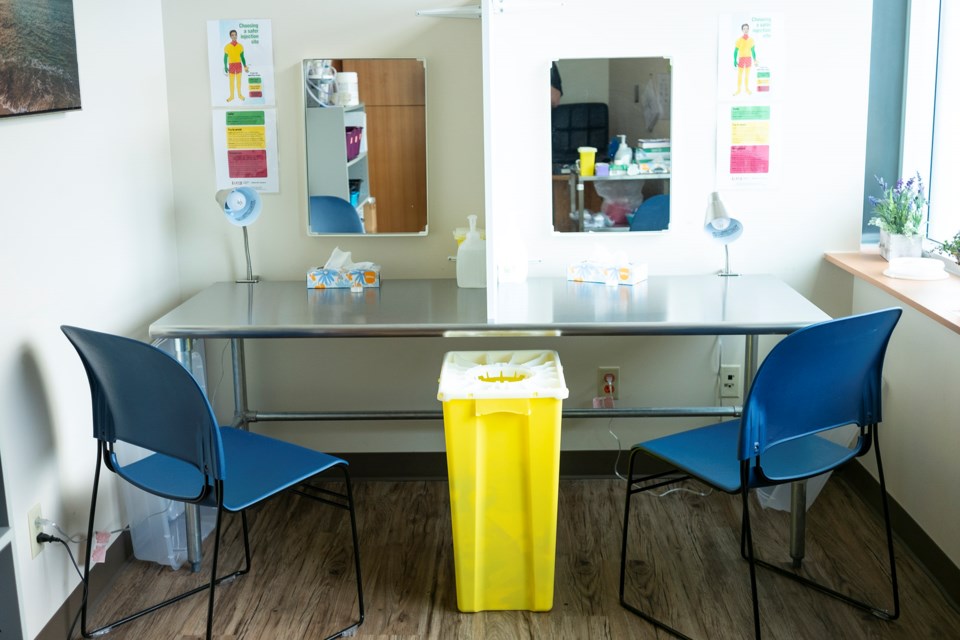Each Friday, the public is being invited to tour Guelph’s only Overdose Prevention Site. The executive director of the Guelph Community Health Centre hopes it will be seen by most as providing an essential service in the community.
The Overdose Prevention Site (OPS) in Guelph opened about two months ago and has so far seen over 430 visits by about 100 unique individuals, said Raechelle Devereaux, executive director of the Community Health Centre.
The OPS is located just inside the main lobby of the Community Health Centre. Devereaux notes that its door looks like any other door a member of the public would go through to access heath care services.
“It looks like health care in action, the same way it looks when I go to my doctor's office,” said Devereaux. “Addictions is a health issue and we are treating it like that here.”
Friday marks the third week in a row the Community Health Centre has opened its doors to the public to tour the OPS.
"We are excited to open the doors and show people what actually happens here,” said Devereaux. “It’s health care and dignity around people's lives.”
The site itself is situated in a unit adjacent to the front doors of the Community Health Centre. It consists of a small waiting room and a second using room with a metal table against the wall. A partition splits the table into two spaces with one chair situated at each. A mirror is placed on the wall in front of the client.
"The nurse needs to be able to see the face of the individual at all times so there is continuous monitoring," noted Devereaux.
A large yellow biomedical waste box for used sharps and other waste stands between the chairs. Votive candles sit on the table at each of the two stations.
"That's for cooking," said Devereaux.
The using room is supervised at all times with a nurse and the waiting room is staffed by a peer support worker.
People who use the OPS are given a unique identifier, which assists in the collection of statistics about the site while protecting the privacy of the client. Each person who uses the site must also sign a waiver that they will not drive after using and that they assume liability should they leave against medical advice. The trafficking of illicit substances on site is strictly prohibited.
The OPS does not dispense drugs, the clients bring their own, but there are sterile needles and cookers available for use.
"We would encourage people to use our supplies because it reduces the risk of infection," said Devereaux.
With two months of data showing that 84 per cent of people who use the OPS are coming in to use opioids, Devereaux said it is clear there is a need for the site in the community.
"The data showed me that we continue to see a need for people to access services to prevent overdoses in our community. It showed me there is a breadth of people using opioids in our community and that they wish to reduce the harms around their use and are willing to access services designed around doing that,” said Devereaux.
The data also shows that five people have overdosed at the site, requiring an intervention.
"We had one on Tuesday morning and one on Saturday — so that is two within the span of four days,” said Devereaux. “That is pretty significant.”
Those two interventions required the administration of Naloxone, said Devereaux.
She notes that people who die of overdoses usually die alone.
“They die because of the stigma associated with drug use and they die by themselves,” said Devereaux. “Overdose death is silent. I think what we see in the site here is there is not silence — there's people connecting, there's people connected to services, people are getting health care, people are getting connected to resources and there's not silence around their lives.”
As some members of the community die from overdose, the OPS serves another function.
"I am hearing from the community that there has been some deaths that are near and dear to those in our community and we see at the site when it happens that people come for various sorts of connections, they come to grieve the loss of one of their community members,” said Devereaux.
She added: “when people see friends and loved ones are dying of Fentanyl and overdoses, they come somewhere they can use safely.”
Nurses do not attempt to talk clients out of using. One of the philosophies of harm reduction is accepting that recovery is a journey and to accept somebody where they are in that journey, said Devereaux.
"If someone says 'I am ready to quit,' — in that moment I connect them to a social worker or a specialized outreach worker who is able to walk them through the next step,” said Devereaux. “That conversation likely wouldn't happen if I opened the door and asked, 'would you like to quit today?' In that moment they would likely feel judged, feel like I was imposing what I think they should do on their life.”
Hand-drawn signs hang in various spots in the OPS waiting room, which Devereaux said were likely made by clients in an attempt to support one another.
The signs carry messages like, ‘no matter what you do, you are worth it” and ‘today I have the power to change my story’. Some are have names of the people they are directed at.
“People believe their lives matter and that we show them their lives matter by developing a service that helps to keep them alive and keep them with us,” said Devereaux.
 Outer door to the Overdose Prevention Site at Guelph Community Health Centre. Kenneth Armstrong/GuelphToday
Outer door to the Overdose Prevention Site at Guelph Community Health Centre. Kenneth Armstrong/GuelphTodayTours of the OPS are being organized every Friday starting at 9:15 at the Community Health Centre’s 176 Wyndham St. N. location on an ongoing basis. Visitors are asked to check in at main reception upon arrival.
So far, most of the visitors to the tours have been community partners who also provide services to the same demographic the OPS sees, but Devereaux hopes more neighbouring businesses and members of the public will come in to see what they are all about.
I think that's one of the things that can happen in the absence of information is you can conjure up all kinds of ideas about what might be happening and that is based in fear,” said Devereaux.
She hopes the data collected so far will inform the policies of the new OntarioPC government, though during his campaign, premier Doug stated he was ‘dead against’ supervised injection sites.
"I hold out confidence that health will be designed around evidence-based practices and that there will be a continued commitment to deliver programs and services that include treatment and harm reduction in the wake of the current overdose crisis," said Devereaux.
She added: "When health policy is informed by ideology — what somebody thinks or somebody believes as opposed to evidence — we get into trouble.”
